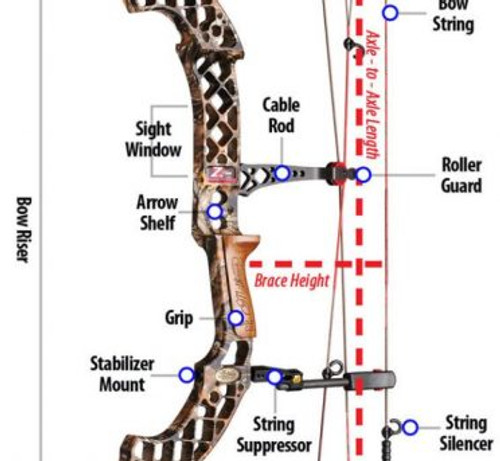PARTS OF A COMPOUND BOW
Mar 9th 2018
If you’re interested in becoming an advanced archer for competitions, hunting, or recreation, you need two things — TONS of practice and an in-depth understanding of every part of your bow.
Do you know the name of all the compound bow parts and what they’re used for? Are you familiar with the modifications and developments made in archery over the last few years? There has been a lot of evolution in the engineering and development of bows and arrows, but the anatomy of a compound bow has remained pretty consistent as of late. If you need to learn more about compound bow components, this article is for you.
String
This is the most important part of a bow in our opinion! The string stretches from cam to cam on a two-cam system. On a solo cam system, the bowstring ends at the single cam, but the string travels around the top idler wheel.
Riser
This is the compound bow part that all limbs and accessories attach to. It’s also where you’ll find the grip. Make sure you inspect your bow for cracks and dents because they could be causing unnecessary vibrations in your arrow shots.
Limbs
The limbs are a main part of the bow and give bows their overall shape. The limbs are flexible fiberglass planks that are attached to the riser on one end and support the cam or idler wheel at the other end. Limbs allow for flexing, which translates into energy build-up as the bow is drawn.
The limbs of your bow should be screwed down tightly at all times when shooting. Because they’re such an essential compound bow part, always make sure there are no cracks in the limbs. You will need to replace the limbs periodically because they lose their springiness over time.
Arrows
Arrows aren’t technically a compound bow component, but they are important enough to mention here. They are most often made from aluminum or carbon or both. The most popular choice for archers tends to be carbon because it maintains its shape (straightness) and is much more durable. Another advantage of the carbon arrow is its preferable weight to spine ratio.

Berger Hole
Next up for the anatomy of a compound bow is the Berger hole. It’s the compound bow part that’s a tapped hole above the arrow shelf. The arrow rest is screwed from the outside of the riser into the Berger hole. Upon setting your bow, make sure that the arrow is centered in the middle of the Berger hole.
Bow Sling
A bow wrist sling is the part of a bow that’s installed along with a stabilizer. This prevents archers from dropping their bows after taking a shot. Make sure to install your sling loosely so you don’t have to add torque when an arrow is fired.
Cables
The cables are a compound bow part that appear similar to the bowstring. It runs from one cam to another. The cables work with the cams when a shot is executed.
Cable Slide
The cable slide attaches to the cable guard and holds the string and cables out of your line of fire. The cable slide ensures the arrow is not impeded by the string and cables.
Bow Sight
This part of the anatomy of a compound bow is mounted to the front of the bow in the sight window of the riser. The bow sight allows for pinpoint accuracy during aiming. If you find that your arrows aren’t landing where you’re aiming, you likely need to adjust the bow sight.
Peep Sights
This compound bow part is used while aiming the bow and consists of a circular plastic or metal piece that is inserted into the bowstring. The peep sight enables the archer to line up the arrow’s trajectory with the front sight.
Arrow Rest
The arrow rest holds your arrow when the bow is drawn. Like many compound bow components, there is an alternate name for the rest — the arrow shelf.
Stabilizer
Stabilizers are rods that absorb vibration during the release of the arrow and provide a counterbalance for the weight of the bow when it is drawn. This compound bow part can be over 28″ when used for applications such as indoor target shooting.
60X Custom Strings
We specialize in a number of different bowstrings for compound bows, crossbows, and recurve bows as well as accessories for sights and stabilization. Read our blog for more updates, news, and advice, or reach out to our team for assistance finding the perfect strings for your bow.







